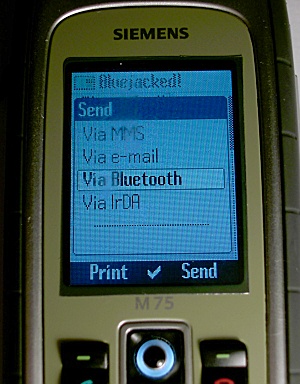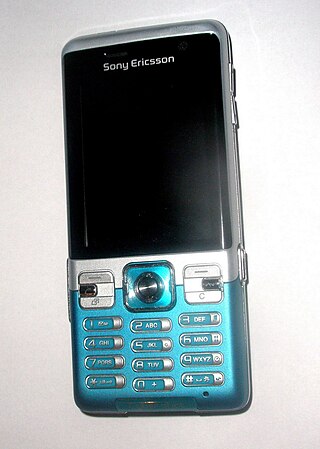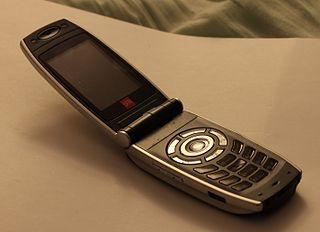The Motorola MPx200 smartphone was launched in December 2003 as a joint venture between Motorola and Microsoft. The mobile phone's Windows Mobile for Smartphone OS allows users to access email and the Internet, use MSN Messenger, and view documents in Microsoft Office formats much like other Windows smartphones such as the Samsung SGH-i600 or HTC Tanager. The MPx200, along with the Samsung SCH-i600, were the first Windows Mobile smartphone devices to have wide distribution in the United States. Previously, smartphone platform devices could only be purchased in the United States as part of development kits sold by Microsoft. The only U.S. carrier of the phone was AT&T Wireless; however, reports also suggest a somewhat limited number of devices with Cingular branding have appeared following the purchase of AT&T Wireless by Cingular.

The Sony Ericsson T610, released in 2003, is a mobile phone manufactured by Sony Ericsson. It was one of the first widely available mobile phones to include a built-in digital camera, Bluetooth, color screen, joystick navigation, and was a very high selling model. The T630 was a later variant.
The O2 Xda brand was a range of Windows Mobile PDA phones, marketed by O2, developed by O2 Asia and manufactured by multiple OEMs (mainly HTC, Quanta and Arima). The first model was released in June 2002. The last models came to market in 2008. The "X" represents convergence of voice and information/data within one product; the "DA" stands for "Digital Assistant", as in PDA. The name of XDA is derived from it.

Motorola A925 is a 3G mobile phone from Motorola using Symbian OS. Among the most notable features is its built-in A-GPS. The A925 was preceded by the featurewise essentially identical Motorola A920, and was succeeded by the Motorola A1000.

The Siemens M75, this is the successor of Siemens M65. The phone released in 2005, is manufactured by BenQ Mobile. It is one of the few mobile phones to be weather and shock resistant, while not skimping on other features like a 1.3MP digital camera, 262k color screen and a digital music player supporting the MP3 and AAC formats. It comes in 2 color variants, safari green and black.

The Sony Ericsson K800i, and its variant, the Sony Ericsson K790, are mobile phone handsets manufactured by Sony Ericsson. Launched in July 2006, the phones are the successor to the Sony Ericsson K750i, and are the first to be tagged with the Sony Cyber-shot branding. Both of the phones feature a 3.2-megapixel digital camera complete with a xenon flash, a protective lens cover, and a new "BestPic" bracketing feature. The new "BestPic" feature takes 9 full quality snapshots of a subject in quick succession, allowing the user to choose the best shots from them. On the entertainment front, the phones have a media player supporting MP3, AAC/AAC+/eAAC+ and WMA music files and 3GP/MPEG-4 video files. The phones also feature a RDS FM radio, and a Memory Stick Micro (M2) slot for expandable solid state memory. The K790/K800 models are also the first Sony Ericsson mobile phones to use ATI's Imageon 2192 graphics engine, which delivers a full 3D gaming graphics for Java and full support for its 3.2-megapixel camera. It is the phone used by James Bond in the 2006 Casino Royale film and trailers.
The Motorola E770 mobile phone is a 3G phone that operates primarily on the third generation phone network; however, it can be downscable to GPRS 2.5 and below if required.
Motorola Krzr, known as the "Canary" before its release, is a series of clamshell/flip mobile phones by Motorola, and was one of the series in the 4LTR line. It consisted of the K1 (2006) followed by the K3 (2007). As a clamshell/flip phone, the Krzr is longer but narrower than the Motorola Razr V3.
BenQ-Siemens SL91 is a slider-type GSM 3G mobile phone, created by BenQ Mobile and introduced in July 2006. The SL91 phone is the successor of Siemens SL75 and BenQ-Siemens SL80. this phones was stylish slider drawing inspiration and development from the previous Siemens Mobile”SL family“ Siemens SL55. SL65 and Siemens SL75.

The Nokia 6111 is a mid-level GSM mobile phone released in June 2005. It sold in Asia, Europe, Australia, Brazil and in Mexico, but was not taken by any carriers in the United States.

The Siemens CX75 was released in 2005, and is a mobile phone manufactured by BenQ Mobile.

The Sony Ericsson K850i is a high-end mobile phone when released in October 2007. It was announced in June 2007 as the flagship product in Sony Ericsson's K ("Kamera") series, with a 5 megapixel CMOS camera sensor. The K850 was the first Sony Ericsson phone released outside of NTT DoCoMo to support microSD and microSDHC along with Sony's traditional M2. It also introduces the usage of three touch-sensitive softkeys right under the display and a new form of navigation button, omitting the classic joystick introduced with the Ericsson T68. The camera interface has been revamped to resemble the format of cybershot digital cameras. According to the manufacturer the UMTS talk time has been significantly increased to 3 hours 30 min over its predecessor, the K800 and K810.. It was Sony Ericsson's first 3.5G HSDPA supporting mobile phone, and was also the first 3G "global" mobile with supporting all major operating network frequency in the world including GSM 850, GSM 900, GSM 1800, GSM 1900, HSDPA, UMTS 850, UMTS 1900, UMTS 2100.

The Nokia 6600 slide is a mobile phone series by Nokia. It includes the original 6600 slide and the updated 6600i slide. The phone runs the Series 40 5th edition platform, including Feature Pack 1. This is the slide version of updated Nokia 6600 series.
The HTC Touch 3G is a Windows Mobile smartphone developed by the High Tech Computer Corporation of Taiwan. It was announced in September 2008 and released the following November. Part of the HTC Touch Family, it features quad band GSM and dual band UMTS connectivity, as well as a version of the proprietary TouchFLO 3D user interface developed by HTC.
The Nokia 6301, approved by the FCC for the US market in January 2008, is a triband GSM mobile phone. The North American model 6301b is equipped with 850/1800/1900 MHz bands. The European model 6301 is equipped with 900/1800/1900 MHz bands.

Sony Ericsson C702 is a mobile phone handset manufactured by Sony Ericsson. The phone features a 3.2-megapixel digital camera with LED flash and a few features such as geo-tagging and face detection. On the entertainment front, the phone has a media player supporting MP3, AAC/AAC+/eAAC+ and WMA music files and 3GP/MPEG-4 video files. The phone also features a RDS FM radio, and a Memory Stick Micro (M2) slot for expandable solid state memory

The Sharp GX25 is a tri-band GSM mobile phone designed by Sharp Corporation.
The Sharp GX29 is a tri-band GSM mobile phone designed by Sharp Corp(Japan).

The Nokia E75 is a mobile phone from the Eseries range with a side sliding QWERTY keyboard and also front keypad.































